副词的用法和位置精讲
- 格式:docx
- 大小:12.42 KB
- 文档页数:1

副词的用法和位置精讲 The Standardization Office was revised on the afternoon of December 13, 2020副词的用法和位置精讲1)副词修饰动词、形容词或其他副词,表示动作、状态的特征或某种性质的程度。
根据其用途与含义,副词可分为下列六大类:(1)时间副词。
常用的有:ago,before,now,then,soon,already,yet等。
(2)地点副词。
常用的有:here,there,up,down,above,below,inside,outside 等。
(3)疑问副词。
常见的有:where,when,why,how等。
(4)程度副词。
常见的有:very,much,so,too,quite,enough等。
(5)方式副词。
多由“形容词+ly”后缀构成。
如:carefully,quickly,easily,quietly等。
(6)频度副词。
常用的有:always,often,sometimes,usually,hardly,never等。
2)副词在句中主要用作状语。
也可充当定语、表语等。
如:It’s snowing heavily outside.(状语,修饰动词)I have never heard such a beautiful voice.(状语,修饰动词)unluckily, he failed in this physics exam again.(状语,修饰整个句子)He was too excited to say a word.(状语,修饰形容词)Class is over.(表语)The weather here is different from that of Singapore.(定语)3)程度副词通常位于被修饰的形容词副词之前,但enough则要放在后面。
如:It was much more freezing today than yesterday.He ran so fast that I couldn’t catch up with him.We got up early enough to catch the first bus.4)频度副词通常位于行为动词之前,be动词、助动词和情态动词之后,但一般不放在句末。
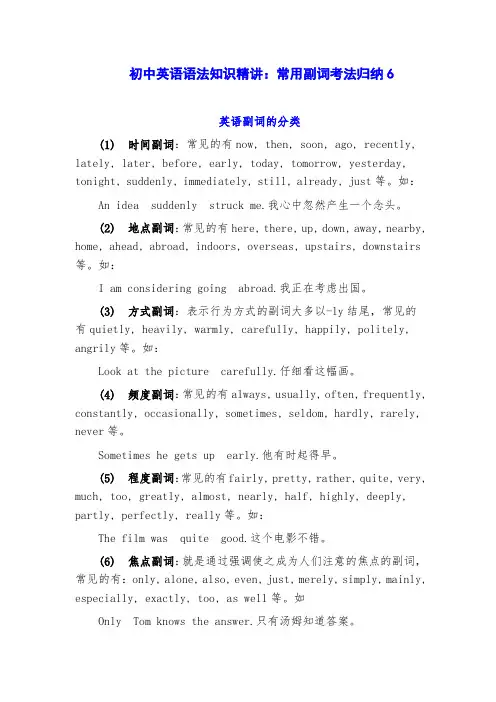
初中英语语法知识精讲:常用副词考法归纳6英语副词的分类(1) 时间副词:常见的有now, then, soon, ago, recently, lately, later, before, early, today, tomorrow, yesterday, tonight, suddenly, immediately, still, already, just等。
如:An idea suddenly struck me.我心中忽然产生一个念头。
(2) 地点副词:常见的有here, there, up, down, away, nearby, home, ahead, abroad, indoors, overseas, upstairs, downstairs 等。
如:I am considering going abroad.我正在考虑出国。
(3) 方式副词:表示行为方式的副词大多以-ly结尾,常见的有quietly, heavily, warmly, carefully, happily, politely, angrily等。
如:Look at the picture carefully.仔细看这幅画。
(4) 频度副词:常见的有always, usually, often, frequently, constantly, occasionally, sometimes, seldom, hardly, rarely, never等。
Sometimes he gets up early.他有时起得早。
(5) 程度副词:常见的有fairly, pretty, rather, quite, very, much, too, greatly, almost, nearly, half, highly, deeply, partly, perfectly, really等。
如:The film was quite good.这个电影不错。
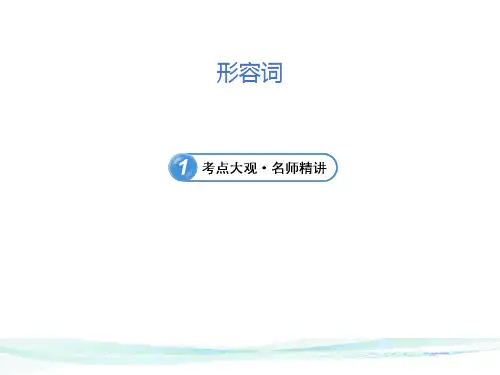
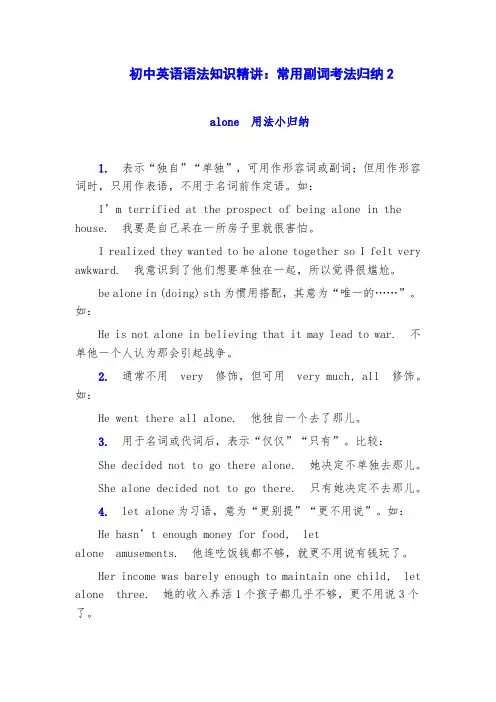
初中英语语法知识精讲:常用副词考法归纳2alone 用法小归纳1.表示“独自”“单独”,可用作形容词或副词;但用作形容词时,只用作表语,不用于名词前作定语。
如:I’m terrified at the prospect of being alone in the house. 我要是自己呆在一所房子里就很害怕。
I realized they wanted to be alone together so I felt very awkward. 我意识到了他们想要单独在一起,所以觉得很尴尬。
be alone in (doing) sth为惯用搭配,其意为“唯一的……”。
如:He is not alone in believing that it may lead to war. 不单他一个人认为那会引起战争。
2.通常不用very 修饰,但可用very much, all 修饰。
如:He went there all alone. 他独自一个去了那儿。
3.用于名词或代词后,表示“仅仅”“只有”。
比较:She decided not to go there alone. 她决定不单独去那儿。
She alone decided not to go there. 只有她决定不去那儿。
4.let alone为习语,意为“更别提”“更不用说”。
如:He hasn’t enough money for food, letalone amusements. 他连吃饭钱都不够,就更不用说有钱玩了。
Her income was barely enough to maintain one child, let alone three. 她的收入养活1个孩子都几乎不够,更不用说3个了。
其后若接动词,通常与前面相关动词形式相同。
如:The baby can’t even sit up yet, let alone walk! 这个婴儿连坐都坐不稳,更不用说走路了。

副词的正确位置和用法详解副词是一类修饰动词、形容词、其他副词等词性的词语,它可以进一步说明或限定句子中其他词的意义。
在英语中,副词的位置和用法常常是学习者困惑的点之一。
正确使用副词不仅可以提高语言的准确性和表达的清晰度,还能使句子更加流畅自然。
本文将详细介绍副词的正确位置和用法,帮助读者更好地理解和运用副词。
一、副词在句子中的位置1. 修饰动词:副词通常放在动词之前,用来修饰动词,起到进一步说明动作的作用。
例如:He quickly ran to catch the bus.(他迅速地跑去赶公车。
)She often goes to the gym.(她经常去健身房。
)2. 修饰形容词或副词:副词一般位于形容词或副词之前,用来进一步修饰和限定形容词或副词的程度。
例如:It was a very interesting movie.(那是一部非常有趣的电影。
)She sings beautifully.(她唱歌得很漂亮。
)3. 位于句首或句尾:有些副词可以放在句子的开头或结尾,用来强调整个句子或句子的部分。
例如:Unfortunately, I forgot to bring my umbrella.(不幸的是,我忘记带伞了。
)I will go there tomorrow, definitely.(我明天一定会去那里。
)二、常见副词的用法1. 时间副词:时间副词用来描述动作发生的时间,常常放在句首或句末。
例如:Yesterday, I went to the park.(昨天,我去了公园。
)We will leave soon.(我们即将离开。
)2. 地点副词:地点副词用来描述动作发生的地点,通常放在动词之后,或者与动词连用形成短语。
例如:She put the book here.(她把书放在这里。
)He went downstairs to get some water.(他下楼去取水。
)3. 方式副词:方式副词用来说明动作的方式或方式的特征,通常放在动词之前。

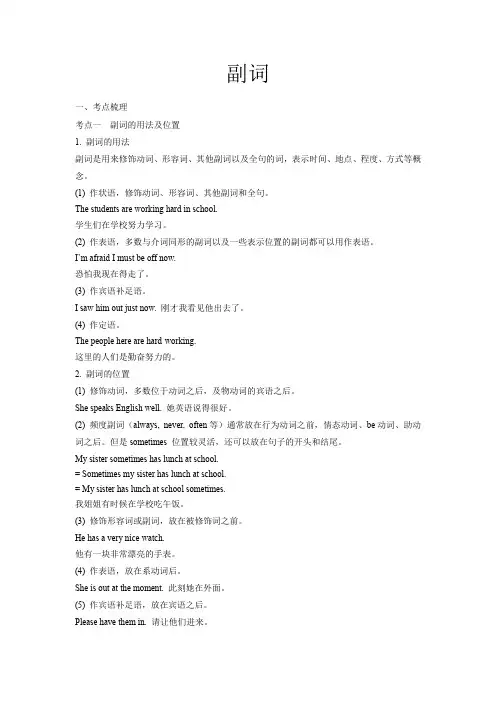
副词一、考点梳理考点一副词的用法及位置1. 副词的用法副词是用来修饰动词、形容词、其他副词以及全句的词,表示时间、地点、程度、方式等概念。
(1) 作状语,修饰动词、形容词、其他副词和全句。
The students are working hard in school.学生们在学校努力学习。
(2) 作表语,多数与介词同形的副词以及一些表示位置的副词都可以用作表语。
I’m afraid I must be off now.恐怕我现在得走了。
(3) 作宾语补足语。
I saw him out just now. 刚才我看见他出去了。
(4) 作定语。
The people here are hard-working.这里的人们是勤奋努力的。
2. 副词的位置(1) 修饰动词,多数位于动词之后,及物动词的宾语之后。
She speaks English well. 她英语说得很好。
(2) 频度副词(always, never, often等)通常放在行为动词之前,情态动词、be动词、助动词之后。
但是sometimes 位置较灵活,还可以放在句子的开头和结尾。
My sister sometimes has lunch at school.= Sometimes my sister has lunch at school.= My sister has lunch at school sometimes.我姐姐有时候在学校吃午饭。
(3) 修饰形容词或副词,放在被修饰词之前。
He has a very nice watch.他有一块非常漂亮的手表。
(4) 作表语,放在系动词后。
She is out at the moment. 此刻她在外面。
(5) 作宾语补足语,放在宾语之后。
Please have them in. 请让他们进来。
(6) 修饰全句,放在句首。
Perhaps/Maybe he’s watching TV at home.也许他正在家里看电视。
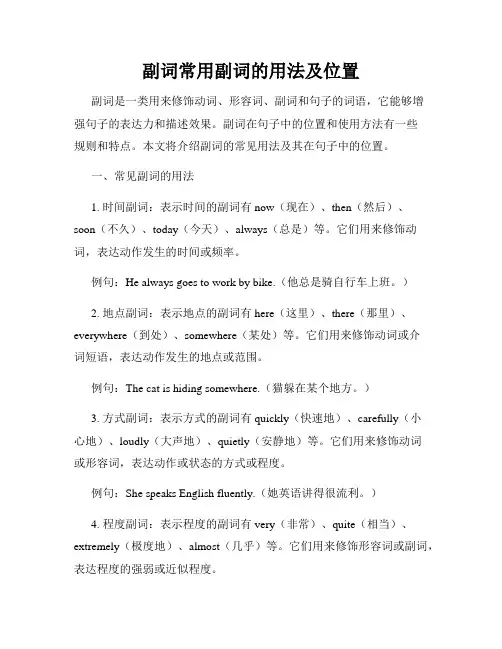
副词常用副词的用法及位置副词是一类用来修饰动词、形容词、副词和句子的词语,它能够增强句子的表达力和描述效果。
副词在句子中的位置和使用方法有一些规则和特点。
本文将介绍副词的常见用法及其在句子中的位置。
一、常见副词的用法1. 时间副词:表示时间的副词有now(现在)、then(然后)、soon(不久)、today(今天)、always(总是)等。
它们用来修饰动词,表达动作发生的时间或频率。
例句:He always goes to work by bike.(他总是骑自行车上班。
)2. 地点副词:表示地点的副词有here(这里)、there(那里)、everywhere(到处)、somewhere(某处)等。
它们用来修饰动词或介词短语,表达动作发生的地点或范围。
例句:The cat is hiding somewhere.(猫躲在某个地方。
)3. 方式副词:表示方式的副词有quickly(快速地)、carefully(小心地)、loudly(大声地)、quietly(安静地)等。
它们用来修饰动词或形容词,表达动作或状态的方式或程度。
例句:She speaks English fluently.(她英语讲得很流利。
)4. 程度副词:表示程度的副词有very(非常)、quite(相当)、extremely(极度地)、almost(几乎)等。
它们用来修饰形容词或副词,表达程度的强弱或近似程度。
例句:I'm very happy to see you.(见到你我很高兴。
)5. 频率副词:表示频率的副词有often(经常)、sometimes(有时候)、rarely(很少)、never(从不)等。
它们用来修饰动词,表达动作发生的频率或概率。
例句:She rarely eats fast food.(她很少吃快餐。
)二、副词在句子中的位置1. 修饰动词:副词通常放在动词之前,用来修饰动词,表示动作的方式、时间、地点等。
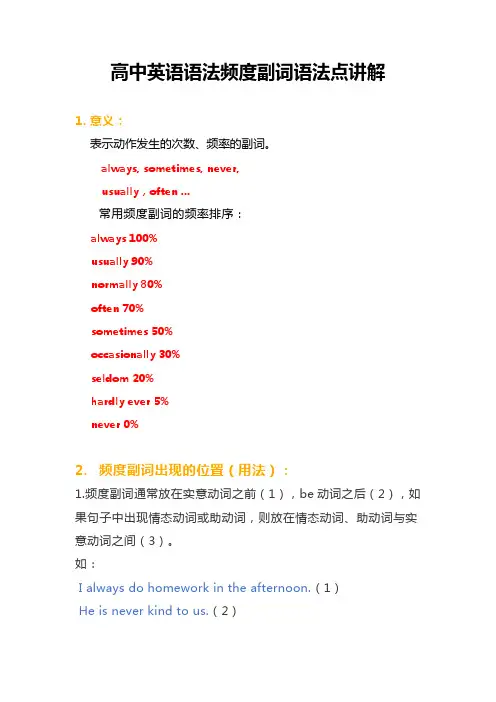
高中英语语法频度副词语法点讲解1.意义:表示动作发生的次数、频率的副词。
always, sometimes, never,usually,often ...常用频度副词的频率排序:always 100%usually 90%normally 80%often 70%sometimes 50%occasionally 30%seldom 20%hardly ever 5%never 0%2. 频度副词出现的位置(用法):1.频度副词通常放在实意动词之前(1),be动词之后(2),如果句子中出现情态动词或助动词,则放在情态动词、助动词与实意动词之间(3)。
如:I always do homework in the afternoon.(1)He is never kind to us.(2)She can never know your secret.(3)2.频度副词的特殊位置:表示次数的频度副词,如once, twice,可以放在动词后或句末(4);有的频度副词也可放在句首表示强调(5)。
如:The car broke down twice.(4)Sometimes I go fishing with my dad.(5)3. 常用频度副词精讲:1. always 频率最高,表示动作重复、状态继续,表示“一直、总是”,其反义词为never。
always等与not连用时,表示部分否定。
如:The rich are not always happy. 有钱的人并不总是快乐的。
如果要变为否定句,应将always改为never才能全部否定。
如:Li Ping is always late for school. 李平上学总是迟到。
Li Ping is never late for school.(全部否定)Li Ping is not always late for school. (部分否定)频度副词通常和一般现在时连用,表示动作发生的频率。
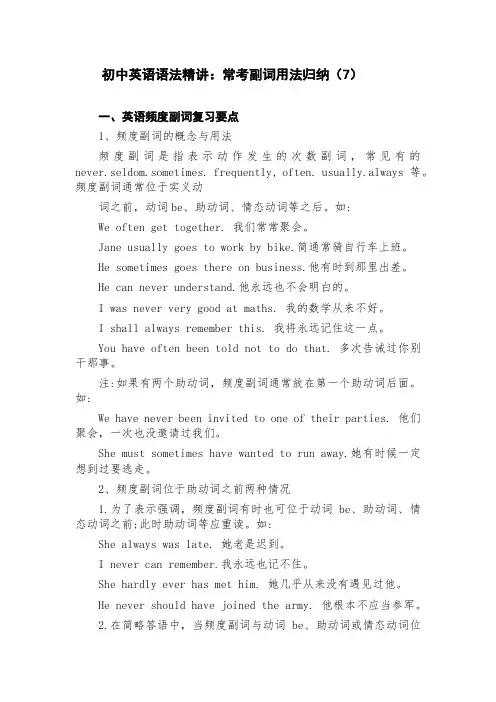
初中英语语法精讲:常考副词用法归纳(7)一、英语频度副词复习要点1、频度副词的概念与用法频度副词是指表示动作发生的次数副词,常见有的never.seldom.sometimes. frequently, often. usually.always 等。
频度副词通常位于实义动词之前,动词be、助动词、情态动词等之后。
如:We often get together. 我们常常聚会。
Jane usually goes to work by bike.简通常骑自行车上班。
He sometimes goes there on business.他有时到那里出差。
He can never understand.他永远也不会明白的。
I was never very good at maths. 我的数学从来不好。
I shall always remember this. 我将永远记住这一点。
You have often been told not to do that. 多次告诫过你别干那事。
注:如果有两个助动词,频度副词通常放在第一个助动词后面。
如:We have never been invited to one of their parties. 他们聚会,一次也没邀请过我们。
She must sometimes have wanted to run away.她有时候一定想到过要逃走。
2、频度副词位于助动词之前两种情况1.为了表示强调,频度副词有时也可位于动词be、助动词、情态动词之前;此时助动词等应重读。
如:She always was late. 她老是迟到。
I never can remember.我永远也记不住。
She hardly ever has met him. 她几乎从来没有遇见过他。
He never should have joined the army. 他根本不应当参军。
2.在简略答语中,当频度副词与动词be、助动词或情态动词位干句末时,频度副词必须前置。
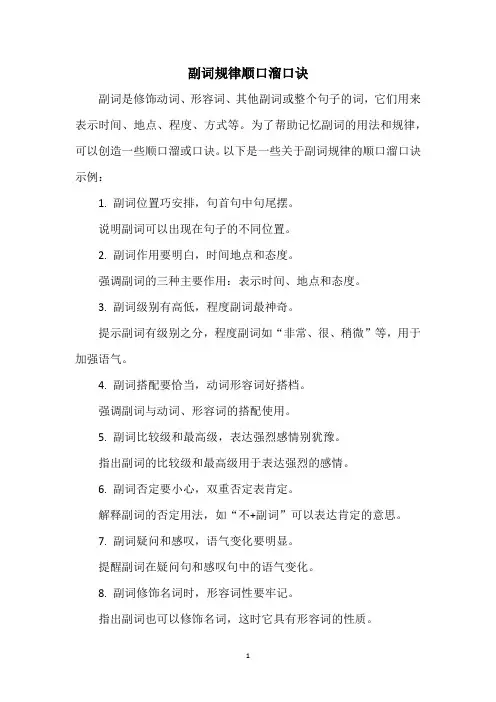
副词规律顺口溜口诀
副词是修饰动词、形容词、其他副词或整个句子的词,它们用来表示时间、地点、程度、方式等。
为了帮助记忆副词的用法和规律,可以创造一些顺口溜或口诀。
以下是一些关于副词规律的顺口溜口诀示例:
1. 副词位置巧安排,句首句中句尾摆。
说明副词可以出现在句子的不同位置。
2. 副词作用要明白,时间地点和态度。
强调副词的三种主要作用:表示时间、地点和态度。
3. 副词级别有高低,程度副词最神奇。
提示副词有级别之分,程度副词如“非常、很、稍微”等,用于加强语气。
4. 副词搭配要恰当,动词形容词好搭档。
强调副词与动词、形容词的搭配使用。
5. 副词比较级和最高级,表达强烈感情别犹豫。
指出副词的比较级和最高级用于表达强烈的感情。
6. 副词否定要小心,双重否定表肯定。
解释副词的否定用法,如“不+副词”可以表达肯定的意思。
7. 副词疑问和感叹,语气变化要明显。
提醒副词在疑问句和感叹句中的语气变化。
8. 副词修饰名词时,形容词性要牢记。
指出副词也可以修饰名词,这时它具有形容词的性质。
9. 副词前后要注意,位置不同意义异。
强调副词在句子中的位置不同,意义也可能发生变化。
10. 副词用法千变万化,掌握规律就不怕。
总结副词用法的多样性,但只要掌握规律,就能灵活运用。
这些顺口溜口诀可以帮助学习者更好地理解和记忆副词的用法和规律。
在实际教学中,可以根据学生的具体情况和需要,创造更多适合他们的顺口溜口诀。
最全频度副词讲解!赶快来学⼀学!世界500强商务英语坚持每天学⼀点,让您在职场更出众!在英⽂中⽤来表⽰动作频率的词被称为“频度副词”,例如:usually/sometimes/always/等,这些词在程度上有区别。
1. 意义表⽰动作发⽣的次数、频率的副词。
always, sometimes, never,usually,often ...常⽤频度副词的频率排序:always 100%usually 90%normally 80%often 70%sometimes 50%occasionally 30%seldom 20%hardly ever 5%never 0%2. ⽤法1.频度副词通常放在实意动词之前(1),be动词之后(2),如果句⼦中出现情态动词或助动词,则放在情态动词、助动词与实意动词之间(3)。
如:I always do homework in the afternoon.(1)He is never kind to us.(2)She can never know your secret.(3)2.频度副词的特殊位置:表⽰次数的频度副词,如once, twice,可以放在动词后或句末(4);有的频度副词也可放在句⾸表⽰强调(5)。
如:The car broke down twice.(4)Sometimes I go fishing with my dad.(5)3. 精讲:1. always 频率最⾼,表⽰动作重复、状态继续,表⽰“⼀直、总是”,其反义词为never。
always等与not连⽤时,表⽰部分否定。
如:The rich are not always happy. 有钱的⼈并不总是快乐的。
如果要变为否定句,应将always改为never才能全部否定。
如: Li Ping is always late for school. 李平上学总是迟到。
Li Ping is never late for school.(全部否定) Li Ping is not always late for school. (部分否定) 频度副词通常和⼀般现在时连⽤,表⽰动作发⽣的频率。
初中英语语法精讲:常考副词用法归纳11副词的分类根据副词在句子中所起的作用,我们可以把副词分为:1.时间副词,如:ago, ahead, before, behind, beside, below, soon, now, recently, sometime, today, tomorrow, tonight, then, yesterday等;此外,还有表示频度的副词,如:always, constantly, ever, frequently, hardly, never, occasionally, often, rarely, seldom, sometimes, twice, usually等。
2.地点副词,如:above, abroad, down, downstairs, everywhere, here, home, in, inside, out, outdoors, there, up, upstairs等。
3.疑问副词,如:how, when, where, why 等。
4.方式副词,如:angrily, badly, bravely, calmly, carefully, easily, fast, happily, hurriedly, loud, loudly, quickly, quietly, rapidly, slowly, slightly, suddenly, well 等。
5.程度副词,如:a little, almost, completely, deeply, enough, extremely, fairly, fine and, good and, greatly, hardly, just, much, nearly, partly, pretty, quite, rather, so, terribly, too, very, very much 等。
英语副词的分类及用法一、副词的识别和用法副词在句子中作状语,用来修饰动词、形容词、副词本身或者整个句子。
我们可以通过以下方式来识别副词。
1、以-ly结尾的单一副词。
很多副词由“形容词+ly”构成,如carefully, successfully但要注意的是,“名词+ly”构成的是形容词,如friendly, brotherly, lovely, manly等。
2、在形容词、副词或者介词短语前。
有些副词并不是由加-ly构成的,如often, fast, there, then, very, quite, perhaps等,识别的办法是:如果它们置于形容词或副词前,便可断定是副词。
例如:She asked teachers for advice on her lessons very often. (在副词前)她经常就学习向老师请教。
Generally, our experiment was quite successful.(在形容词前)总的说来,我们的试验相当成功。
Much to my surprise, the cat came to life three days later.(在介词短语前)使我非常惊奇的是,这只猫三天后又活过来了。
3、在动词前或者后面。
修饰动词时,副词常置于动词前,有时也可后置。
例如:We drove slowly on the muddy road.我们在泥泞的路上缓慢地行驶。
4、单独置于句子之首,或者插在句子中间。
单个的词用逗号与句子隔开时,这个词多半是副词,作状语修饰整个句子。
例如:Fortunately, I was absent from the house when the earthquake occurred.幸运的是,地震发生时我不在家。
二、副词的分类1、方式副词。
多由形容词加-ly构成,例如patient / patiently, mad / madly, sudden / suddenly;也包括由-l结尾的形容词,此时l要双写,如beautiful / beautifully;一些介词短语也可以作方式状语。
初中英语语法精讲:副词用法归纳(9)句子副词在句中的位置1、句子副词的特点句子副词用于修饰句子(而不是修饰某个单词),反映说话人的观点和看法,如actually, certainly, clearly, definitely, evidently, fortunately, frankly, honestly, luckily, obviously, perhaps, possibly, probably, surely, undoubtedly, unexpectedly 等。
2、句子副词在句中的位置句子副词通常位于句首(或分句句首):Obviously he can’t tell the difference between them. 显然他无法区别两者的不同。
I arrived late but luckily the meeting had been delayed. 我迟到了,幸而会议推迟了。
但有些句子副词也可以出现在句中:He smiled nastily. He evidently knew something I didn’t. 他发出狞笑,他显然知道一些我所不知道的事。
有的句子副词也可用作其他种类的副词,不过这往往会导致位置和语义的变化:Clearly he didn’t say so. 显然他没有这样说。
(句子副词)He didn’t say so clearly. 他说得没有那么清楚。
(方式副词)Frankly, you are wrong. 说实在的,你错了。
(句子副词) He spoke frankly about his past life. 他坦率地谈了他过去的生活。
(方式副词)副词在句中可用作哪些成分1. 用作状语The evening passed quickly. 晚上很快过去了。
We must think about this seriously. 我们应认真考虑此事。
副词的用法与位置副词是一种用来修饰动词、形容词、副词等其他词类的词语,它能够表达程度、方式、时间、地点等概念,丰富了语言的表达效果。
掌握副词的用法和位置对于提高写作水平和表达能力至关重要。
本文将详细介绍副词的用法和位置,并给出一些例子进行解释。
一、副词的基本用法副词可以用来修饰动词,形容词和副词等。
下面分别从这三个方面来详细解析。
1. 修饰动词副词可以加在动词之前或之后,用以修饰动作的程度、方式、频率等。
(1) 修饰程度:副词可以在动词之前或之后表示动作的程度。
例如:- 他非常努力地学习了一个晚上。
- 她慢慢地走进了教室。
(2) 修饰方式:副词可以在动词之前或之后表示动作的方式。
例如:- 他快乐地唱着歌。
- 她安静地读着书。
(3) 修饰频率:副词可以在动词之前或之后表示动作的频率。
例如:- 我每天都认真地练习钢琴。
- 她偶尔去看望奶奶。
2. 修饰形容词副词可以用来修饰形容词,表示形容词的程度。
例如:- 这个问题非常困难。
- 她非常漂亮。
3. 修饰副词副词还可以用来修饰副词,表示副词的程度。
例如:- 她跑得非常快速。
- 我们一起度过了非常愉快地一天。
二、副词的位置副词的位置通常位于所修饰的词语之前或之后。
下面分别从动词、形容词和副词的角度来详细分析。
1. 修饰动词副词在修饰动词时的位置有以下几种情况。
(1) 位于动词之前:- 经常、常常、频繁地例如:他经常看电影。
(2) 位于动词之后:- 马上、立刻、现在、已经等例如:我们马上出发。
2. 修饰形容词副词在修饰形容词时的位置通常位于形容词之前。
例如:- 非常、特别、很、太等例如:这个方案非常可行。
3. 修饰副词副词在修饰副词时的位置通常位于被修饰的副词之前。
例如:- 非常、极其、更加等例如:这个问题非常复杂。
除了以上的常见位置外,副词的位置还会受到句子结构、语气等因素的影响,有时候会出现在其他位置。
三、副词的常见用法除了以上介绍的用法和位置,副词还有一些常见的特殊用法和搭配。
【一轮复习讲义】2024年高考英语高频考点题型归纳与方法总结(新高考通用)第05讲形容词和副词(精讲)题型目录一览1.形容词的基本用法在句中可作定语、表语、宾语补足语、主语补足语、状语等。
一般情况下,单个的形容词作定语放在被修饰的词之后,形容词短语放在被修饰的词之前。
He is the only man alive in the village after the earthquake.地震后他是那个村子里唯一活着的人。
It is a problem difficult to solve.这是个难以解决的问题。
■名师点津(1)形容词作状语主要表示原因、结果或伴随等,其逻辑主语必须与句子主语保持一致。
Light-hearted and optimistic, she is the sort of woman to spread sunshine to people through her smile.她无忧无虑、积极乐观,是那种用微笑给别人带来快乐的人。
(2)有些以-ly结尾的词是形容词,而不是副词。
常见的有:friendly, lovely, lively, lonely, elderly, deadly 等。
2.副词的基本用法(1) 副词主要用来修饰动词、形容词或其他副词,表示时间、地点、程度、方式等。
(2019·天津卷)A dog’s eating habit requires regular training before it is properly established.狗的饮食习惯在正确建立之前需要定期的训练。
■名师点津有些副词,如fortunately, luckily, surprisingly, honestly, actually, personally等作评注性状语,往往修饰整个句子,而且它们常位于句首,且有逗号与后面的句子分开。
(安徽卷)Thankfully, I managed to get through the game and the pain was worth it in the end.谢天谢地,我终于打完比赛了,所有的辛苦最终都是值得的。
副词的用法和位置精讲
1)副词修饰动词、形容词或其他副词,表示动作、状态的特征或某种性质的程度。
根据其用途与含义,副词可分为下列六大类:
(1)时间副词。
常用的有:ago,before,now,then,soon,already,yet等。
(2)地点副词。
常用的有:here,there,up,down,above,below,inside,outside等。
(3)疑问副词。
常见的有:where,when,why,how等。
(4)程度副词。
常见的有:very,much,so,too,quite,enough等。
(5)方式副词。
多由“形容词+ly”后缀构成。
如:carefully,quickly,easily,quietly等。
(6)频度副词。
常用的有:always,often,sometimes,usually,hardly,never等。
2)副词在句中主要用作状语。
也可充当定语、表语等。
如:
It’s snowing heavily outside.(状语,修饰动词)
I have never heard such a beautiful voice.(状语,修饰动词)
unluckily, he failed in this physics exam again.(状语,修饰整个句子)
He was too excited to say a word.(状语,修饰形容词)
Class is over.(表语)
The weather here is different from that of Singapore.(定语)
3)程度副词通常位于被修饰的形容词副词之前,但enough则要放在后面。
如:
It was much more freezing today than yesterday.
He ran so fast that I couldn’t catch up with him.
We got up early enough to catch the first bus.
4)频度副词通常位于行为动词之前,be动词、助动词和情态动词之后,但一般不放在句末。
如:
I have never been late for class.
You must always work like that.
5)几个副词同时出现时,其顺序一般为:方式副词+地点副词+时间副词(也可位于句首)。